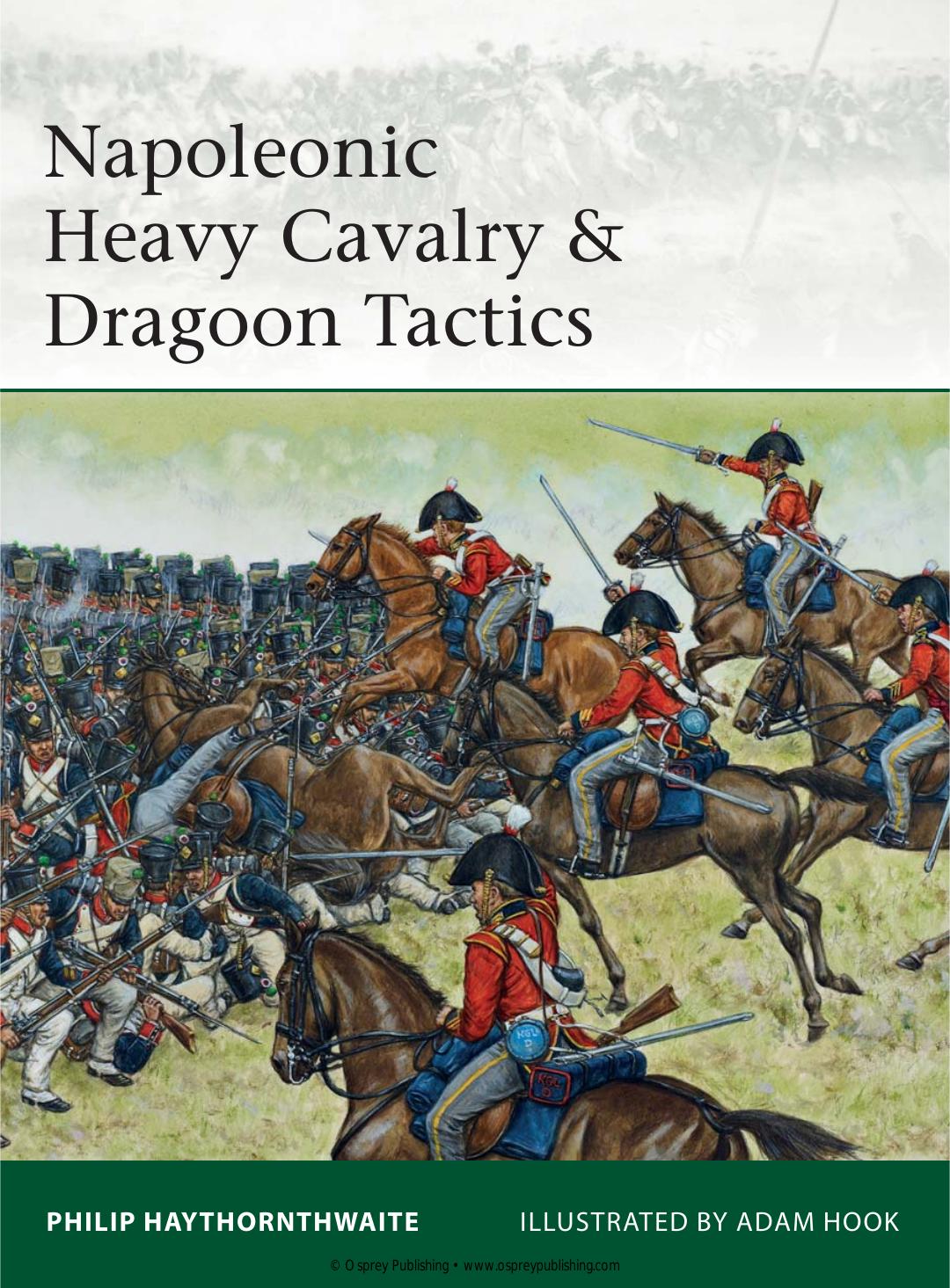Napoleonic Heavy Cavalry & Dragoon Tactics by Philip Haythornthwaite

Author:Philip Haythornthwaite
Language: eng
Format: epub, pdf
Tags: Napoleonic Heavy Cavalry & Dragoon Tactics
ISBN: 9781782009405
Publisher: Osprey Publishing
French dragoons employed as heavy battlefield cavalry: a trooper of the 16e Dragons at the charge. He wears the simpler single-breasted green surtout coatee of this branch, with pink regimental facings and lining, and grey riding overalls buttoned up the outside. This regiment served in the Peninsula, and was among those later withdrawn from Spain to rebuild Napoleon’s badly weakened cavalry for the 1814 French campaign, in which they formed an invaluable resource. (Print after Rozat des Mandres)
Although the performance of the dragoon regiments in the early campaigns of the Empire was somewhat patchy, in the Peninsula they proved highly effective, and were virtually the only heavier cavalry deployed there by the French. They proved adept in all duties, from the battlefield charge to escorts, patrols and anti-guerrilla work, and when withdrawn from Spain to assist Napoleon in 1813–14 they proved battle-hardened and efficient – the most effective of the diminished cavalry in the army that he was having to rebuild once again after the losses in Germany.
One factor that contributed to the effectiveness of Napoleon’s dragoons was their principal firearm, the dragoon musket, which was only about 10cm shorter than that of the infantry (the An IX-XIII pattern had a barrel length of 1.28m/ 50.4 inches). Indeed, it was also carried by some infantry skirmishers, who found its length more handy for their task. The consequence was described by Jonathan Leach, who encountered them in the Peninsula:
The French dragoons … were armed during the Peninsular war with a long fusee [sic], which could throw a ball as far as the musket of an infantry soldier… our dragoons, on the contrary, both light and heavy, were armed with a little pop-gun of a carbine. The consequence of this was, that when bodies of cavalry met at a distance from their infantry, the French dragoons often dismounted where the country was intersected and woody, and shot at our dragoons at a distance which rendered our short carbines almost useless… In the French army, one man was left in charge of three or four horses, out of reach of fire, whilst the dismounted dragoons or chasseurs became efficient light infantry, and acted as such if their own infantry were not up.20
An example of the versatility of such troops occurred at Corunna in 1809, when the French cavalry general Armand Lahoussaye, commanding three dragoon regiments, endeavoured to halt the advance of Edward Paget’s Reserve Division against the French left flank. The terrain was unsuited for conventional cavalry manoeuvres, being intersected with walls and gullies, and Lahoussaye’s attempts to charge were so futile that Paget’s infantry did not even need to form square, but drove them off with rolling volleys. Finding cavalry tactics impractical, Lahoussaye dismounted his 27e Dragons and dispersed them as tirailleurs in a skirmish screen; although they were too few to stop the British advance, the advantages of troops who could dismount and fight effectively on foot were obvious.
Download
Napoleonic Heavy Cavalry & Dragoon Tactics by Philip Haythornthwaite.pdf
This site does not store any files on its server. We only index and link to content provided by other sites. Please contact the content providers to delete copyright contents if any and email us, we'll remove relevant links or contents immediately.
Smithsonian Civil War by Smithsonian Institution(971)
Tiger I and Tiger II (Images of War) by Anthony Tucker-Jones(948)
Battle Cry of Freedom by James M. McPherson(898)
Deadliest Men by Kirchner Paul(776)
The Pacific War by Robert O'Neill(771)
Maps of War by Jeremy Black(747)
Flags of Our Fathers by James Bradley & Ron Powers(742)
D-Day, June 6, 1944: The Climactic Battle of World War II by Stephen E. Ambrose(699)
Third Reich Propaganda (The Third Reich From Original Sources) by Carruthers Bob(693)
Lewes and Evesham 1264-65 by Richard Brooks(662)
The Oxford Illustrated History of the First World War by Hew Strachan(632)
The French Army in the First World War by Ian Sumner(626)
Frames of War by Judith Butler(571)
Early Samurai AD 200-1500 by Anthony J Bryant(560)
American Amphibious Gunboats in World War II by Robin L. Rielly(538)
Battle Cry of Freedom: The Civil War Era (Oxford History of the United States) by McPherson James M(537)
Kursk 1943 by Robert Forczyk(513)
The Civil War by Geoffrey C. Ward(511)
The Nazis – A Warning from History by Laurence Rees(511)
